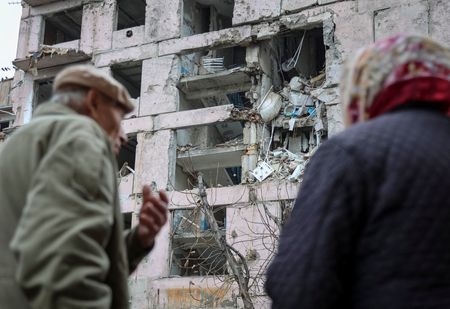HULIAIPOLE, Ukraine (Reuters) -Bundled in layers of clothing and clutching her cane inside an evacuation van, 84-year-old Polina Plyushchii said the threat of drones and other weapons had made it too dangerous to step outside her home near southeastern Ukraine’s front line.
“You’re in your own house, your own yard – and you can’t go out,” she said, preparing to leave the village of Huliaipole, less than 10 km (6 miles) away from fierce battles between Russian and Ukrainian troops.
Ukrainian rescuers are racing to get remaining civilians out of the line of fire along a stretch of the southern front line in Zaporizhzhia region after the security situation abruptly deteriorated in the face of Russian advances in recent days.
Ukraine’s top general, Oleksandr Syrskyi, said on Tuesday the situation had worsened significantly near Huliaipole. The military has said its troops have fallen back from at least six villages in the area over the past two days.
While Ukraine has been evacuating civilians from frontline cities throughout the near four-year-old war, veteran rescuers say it is exceptionally risky now because of swarms of drones that have arrived on the battlefield.
Around 100 km to the northeast, Russian forces appear poised to claim their biggest prize inside Ukraine since early 2024, the ruins of the logistical hub city of Pokrovsk.
Ukrainian soldiers and commanders say they do not have enough troops to hold defensive positions, despite thousands of drones flying above the battlefield which make advances by either side extremely costly.
Russia has been eking out gains in Pokrovsk and beyond by using small, mobile groups of soldiers who probe gaps in enemy defences. Ukraine says many of the troops are killed and wounded but that has not stopped them coming.
In Huliaipole, remnants of nearly four years of fighting litter the landscape: charred, bullet-ridden vehicles lay overturned on the streets and battered appliances spill out of shattered apartment walls.
Rescuers say first person view (FPV) drones guided by fibre-optic cables are a particular threat, because they are immune to the jamming used to fend off drones that are radio-controlled.
“There’s nowhere to buy medicine, there’s no water,” said evacuee Zhanna Puzanova, 55, adding both she and her 88-year-old mother were in poor health.
“We can’t live like that any longer.”
Fleeing residents hold out hope that their home will remain in Ukrainian hands.
“We’ll survive, we’ll last,” said Kateryna Ishchenko, 78. “Our Huliaipole is strong.”
(Additional reporting by Yullia Dysa; Writing by Dan PeleschukEditing by Peter Graff)










